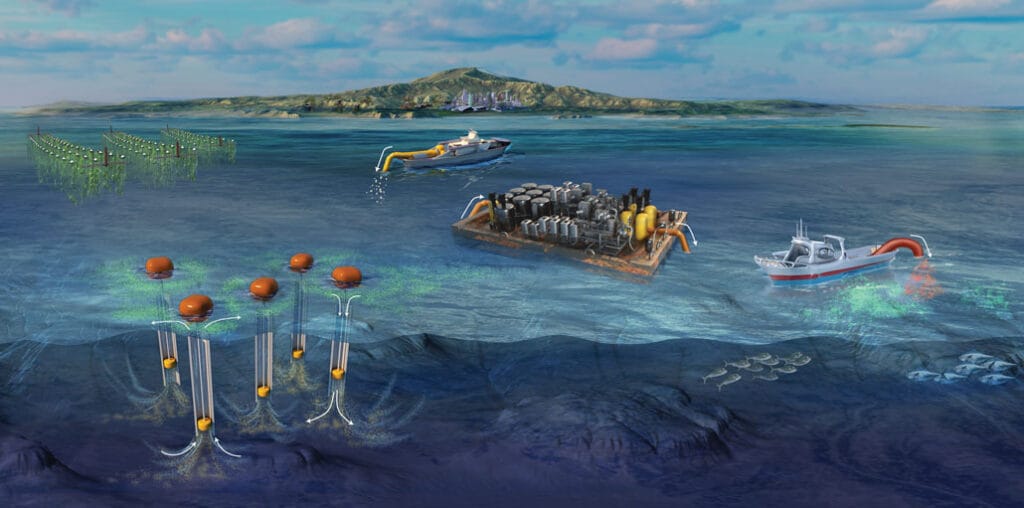The Ocean Oxygen Crisis is deepening, and it’s a topic that demands our immediate and heartfelt attention. It’s a stark reality that even as we work tirelessly to fight climate change, our vast and vital oceans have already lost around 2% of their dissolved oxygen over recent decades. This is a silent but profound change impacting marine life across the globe.

What makes this situation even more complex and urgent is the growing concern that some of the very ocean-based carbon capture techniques that were designed to save us might, inadvertently, be harming marine life instead.
Even more concerning? Techniques like ocean fertilization, seaweed farming, or nutrient upwelling can zap oxygen deep down when algae die and sink. And get this—they can cause up to 40 times more oxygen loss than the CO₂ they capture.
Ocean Oxygen Crisis
| # | Topic | Details |
|---|---|---|
| 1 | O₂ Decline | Approximately 2% drop in dissolved oxygen in oceans over recent decades. |
| 2 | MCDR Risks | Marine carbon dioxide removal methods like ocean fertilization and seaweed sinking can worsen deoxygenation. |
| 3 | O₂ Impact Ratios | These techniques can cause 4 to 40 times more oxygen loss than the amount of CO₂ they remove. |
| 4 | Better Alternatives | Alkalinity enhancement, harvested seaweed, and coastal “blue carbon” ecosystems are safer options. |
| 5 | Real Project | Ebb Carbon is piloting alkalinity enhancement with support from Microsoft. |
| 6 | Nature’s Helpers | Projects in Maine use kelp and mussel farming; seagrass meadows naturally trap carbon. |
| 7 | Blue Carbon Facts | Coastal ecosystems cover 1% of ocean area but store around 50% of its carbon. |
| 8 | Triple Threat | Oceans face three major problems: warming, acidification, and oxygen depletion. |
| 9 | Solution Steps | Combine oxygen monitoring, safe technology, habitat restoration, and local community input. |
| 10 | Official Sources | Trusted organizations include GEOMAR Helmholtz and Ocean Visions. |
Our beloved oceans are currently facing a devastating “triple whammy”: they are battling super-warm temperatures, increasing acidification, and a worrying plummeting of oxygen levels. What makes this even more challenging is that some of the very methods designed to remove carbon dioxide (CO₂) from the atmosphere—like iron fertilization and sinking large amounts of seaweed—can, ironically, make the oxygen (O₂) levels in the ocean even worse. This unintended consequence reminds us of the delicate balance of nature.

What’s Going On—In Plain Terms
Picture a fish tank losing air—that’s what’s happening in parts of the ocean. Warmer water holds less oxygen, and currents are changing. Since mid‑20th century, ocean oxygen‑minimum zones (OMZs) have expanded, threatening marine life.
Worse, harmful algal blooms (HABs)—thanks to fertilizer runoff and warming—steal oxygen when they die, creating dead zones costing US fisheries up to $100 million a year.
It’s like taking three steps forward on climate, then two steps back for our oceans.
Where Carbon Removal Might Backfire
Meaning well doesn’t stop the trouble. Here’s a breakdown:
Ocean Fertilization
Pump in iron to boost phytoplankton, but when they die, deep water rots and wastes oxygen .
Macroalgae Farming + Sinking
Grow seaweed to absorb CO₂—awesome—but dumping it below kills deep‑sea oxygen unless it’s harvested reliably.
Artificial Upwelling
Bring nutrients up to grow algae, same sinking‑rot problem repeats .
Studies show these bio‑solutions can cause 4 to 40 times more O₂ loss than climate warming avoids (geomar.de).
Smarter, Safer Options
Alkalinity Enhancement
Add crushed limestone to boost ocean’s capacity to soak up CO₂ without hurting oxygen. Ebb Carbon is piloting this with Microsoft–backed funding and strict ecological tests.
Harvested Macroalgae & Coastal Blue Carbon
Grow kelp alongside mussels—like Maine’s Bangs Island, harvesting prevents oxygen loss and boosts carbon storage. Coastal habitats, though just 1% of ocean area, hold nearly 50% of ocean carbon.
Seagrass Meadows & Rewilding
Plant seagrass and oysters to trap CO₂ and support ecosystems. Coastal restoration fights hypoxia and improves biodiversity.
Real‑World Wins
- BlueGreen Water Tech uses peroxide to collapse harmful algal blooms, trapping carbon in sediments, sequestering nearly 13,000 tons CO₂e in Utah’s Mantua Reservoir—and plans ocean trials.
- Planetary Technologies in Nova Scotia is trialing magnesium oxide alkalinity to pull CO₂ out—but locals and scientists are cautious about ecosystem impact .
Related Links
Ford Recalls Certain 2024–2025 F-150 Lightning Trucks Over Suspension Issue
Nissan Recalls Over 79,000 Newer Vehicles – Check Which Models Are Impacted
Ocean Oxygen Crisis Action Plan
For Regulators
- Require oxygen testing in all mCDR projects.
- Support coastal restoration and seaweed harvesting over risky bio‑solutions.
- Set up ecosystem‑based permits with community input.
For Companies
- Publish O₂ impact reports transparently.
- Co-design with coastal communities—this ain’t one-size-fits-all.
- Pilot small, scale slowly, measure deeply.
For Scientists
- Use models and AI like OXYGENERATOR to track O₂ trends since 1920.
- Run multi-sensor campaigns—oxygen, CO₂, acid, temperature, biodiversity.
- Explore hybrid nature-engineered solutions: kelp + alkalinity + seagrass.
For Educators & Public
- Make climate‑kid‑friendly: teach fish tank analogy.
- Spread awareness on local projects—kelp farms, oyster reefs.
- Vote for policies that care about climate and ocean health.
FAQs
Q: Will ocean warming alone deplete oxygen?
A: Yup—models project up to 7% drop by 2100. Hypoxia zones already multiply .
Q: Is CO₂ injection banned?
A: Yes—current treaties ban dumping CO₂. Alkalinity is low‑risk, but still under review .
Q: Can fixing climate harm marine life?
A: Absolutely unless we measure the trade‑offs. O₂, biodiversity, nutrient cycles—they all matter.
Q: What’s triple threat?
A: Oceans face extreme heat, acidification, and oxygen loss together, stressing marine systems massively.








